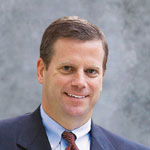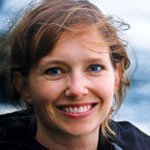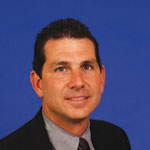PLAYING WITH TYRE
As the lights dim to signal the commencement of the UMBC Theatre Department’s production of William Shakespeare’s Pericles, Prince of Tyre, the audience doesn’t quite know what to expect. The makeshift theater set up in the university’s Imaging Research Center (IRC) already defies expectations: A table for a stage. Actors dressed in all black.
At last, one of the actors picks up a toy man and gives it the deep booming voice of King Antiochus. A version of one of Shakespeare’s more difficult plays – blending technology and stagecraft – takes off.
The creative minds in UMBC’s theatre department never shy away from innovation, so when department chair Alan Kreizenbeck made a mental connection between the leaps of imagination in Pericles and his own observations of his two children at play, he decided to explore the possibility of staging a production of the play using Playmobil figures and other toys. The resulting production – which obtained some of its funding from a Kauffman Innovation Grant – grew into an interdisciplinary collaboration that spanned two semesters and three departments.
“When Alan first suggested it, I thought he was kidding,” said Michele Osherow, a professor of English and a resident dramaturg at the Folger Shakespeare Theatre.
As a prelude to the actual production, Osherow’s dramaturgy class created study and production notes for the creative team, actors and audience. “This is not an easy Shakespeare play,” she explains.
In part, the textual difficulties of Pericles arise from questions of corruption (the play only exists in quarto form, and it was not included in the first collection of Shakespeare’s plays) and disputed authorship (many scholars believe the text was co-written by George Wilkins, a minor Elizabethan author and tavern keeper involved in frequent scuffles with the law).
One goal shared by Osherow and her students was to help audiences shake their fear of such uncertainties in language and textual history. They dug deep into Pericles to uncover the fun in the text. That effort extended into the spring, when the actors cast in the production began to learn how to channel their talents through toys that they manipulated atop a table. Under the direction of the technical director of the Imaging Research Center, Eric Smallwood ’03 and ’10 M.F.A, imaging and digital arts, students in that program created dozens of images that corresponded with the play’s scenes.
The production that emerged married technology and performing arts in innovative ways. As the students played on stage, a camera was trained on the playing space, and this footage was imposed on one of the backgrounds and then projected onto the screen behind the actors. The result was a show that held three focal points for the audience: actors, toys and the images on the screen.
The performance itself reflected the sense of play and collaboration that everyone involved brought to the project. A Shakespeare action figure was used as the play’s narrator. When Pericles fed the hungry citizens of Tarsus with food from his ship, a student poured corn flakes onto the playing area.
“Imagination doesn’t stop just because we outgrow the toys,” said Kreizenbeck.
— Chelsea Haddaway
CREEDS AND CRISES
It’s not often that a historian gives a lecture in a series named in his honor, but that’s precisely what emeritus professor of history Robert K. Webb will do at 4 p.m. on October 27 at the Albin O. Kuhn Library.
The Robert K. Webb lecture is an annual event established by the History Department to honor Webb, a former UMBC professor who is also one of the preeminent historians of Great Britain’s religious and social movements. His talk is titled “The Very Long Eighteenth Century: An Experiment in the History of Religion?”
Reminiscing recently about his career as a historian, Webb recalls that he never had any intention of becoming a scholar whose work focused on religion.
“I sort of backed into working on the history of religion,” Webb says. “I saw myself as a social historian. I did my early work on literacy.”
Webb’s first book, The British Working Class Reader: 1790-1848; Literacy and Social Tension (1955), was part of a wave of research into that era. Webb and other scholars excavated the roots of the empowerment of the working class that fueled the social revolutions which convulsed Britain in the late 17th and 18th centuries.
“And then I became interested in middle-class radicals. I suppose that’s autobiographical to some extent,” Webb chuckles.
Webb first tackled the roots of the tumultuous career of political theorist Harriet Martineau in the Unitarian religion (leading to a 1960 book, Harriet Martineau: A Victorian Radical) and then widened his focus to religion’s importance as an animating force in British and European politics and history. In panoramic works on the era – including Modern England (1968) and Modern Europe (1972), co-written with his eminent colleague and friend Peter Gay – Webb reshaped our notions of how faith led to works of revolution and repression.
Webb says that his lecture will use “the Long 18th Century” – a term coined by University of Kansas professor Jonathan Charles Douglas Clark to describe the unity of religion and politics in Britain from 1660 to 1840 – as the springboard for an even more expansive investigation.
“My talk is about the relationship between religion and science,” Webb says, “or to put it better, religion and reason. I’m taking [Clarke’s] idea and making it into a very long 18th century – from the 1640s to the 1880s. It’s a period in which there was a real symbiosis between religion and science, which only gradually mutated into hostility.”
Renaissance philosopher Francis Bacon (who died in 1626) had argued that religion and philosophy (or science) should be separated, but Webb says that the 1640s marked a long period in which many thinkers abandoned that notion and embraced a belief “that science supports religion, and religion supports science.”
It was only near the end of the 19th century, Webb argues, that there was an explicit return to the notion that Bacon set out. “In the 1880s, it all finally changes,” he says, “and very quickly. And after that, science and religion are at real loggerheads. I can show you this in denomination after denomination.”
— Richard Byrne ’86
LAB LEADER
Ralph Semmel ’92, Ph.D., computer science, is the new director of the renowned Johns Hopkins University Applied Physics Lab (APL). He replaced Richard Roca on July 1 to become the eighth director of APL in the laboratory’s 68-year history.
Located in Laurel, Md., APL has close to 5,000 employees conducting and supporting research related to national defense and security. Semmel has worked at the lab for the past 23 years.
Semmel is a graduate of the U.S. Military Academy at West Point, and he completed master’s degrees at Hopkins and the University of Southern California before pursuing his doctorate at UMBC.
— Richard Byrne ’86
SPLITTING SECONDS
In Anthony M. Johnson’s world, the blink of the eye is an eon.
Indeed, the pulses of light used by Johnson – a professor of physics and of computer science and electrical engineering – in his research are so quick that scientists had to invent new words to describe their elapsed time: picoseconds (a trillionth), femtoseconds (a quadrillionth), and attoseconds (a quintillionth) of a second.
Nature really moves that fast. The initial movement in the seemingly simple act of seeing, for instance, has been measured by lasers and occurs in about 300 femtoseconds – as a photon arrives and triggers a cascade of biochemical events leading to vision.
Johnson is the director of UMBC’s Center for Advanced Studies in Photonics Research (CASPR), and deputy director of the NSF Engineering Research Center, Mid-Infrared Technologies for Health and the Environment (MIRTHE), a collaboration of six research universities including UMBC based at Princeton.
One of Johnson’s main tools is a titanium-doped sapphire laser which emits pulses measured in femtoseconds. His labs consist of large tables on which it appears people have dumped hundreds of mirrors and lenses randomly. In fact, every mirror and lens is in a precise position facing a precise direction to intercept a precise beam of light from a laser.
Johnson’s research is deeply imbedded in the principles of optics and quantum mechanics. Because electronic instruments are too slow, he uses light to measure light. He splits beams of photons, the basic constituent of light, into two streams in a crystal. One stream is altered slightly to add just enough distance to hold its arrival to a determined amount. (Einstein’s Special Theory of Relativity says light always travels at one speed and extending the length of the trip is the only way to delay its arrival).
Another crystal generates a “harmonic” (a doubled frequency) of the merged light nearly instantaneously, which he can measure.
“It has helped us understand how many things work,” he says. “The devices and optical techniques we use uncover the processes in physics and chemistry.”
To make faster microprocessors and integrated circuits, scientists have to understand what happens in the semiconductors, events happening in picoseconds or shorter.
“The only way to measure these ultrafast events is with short pulses of light,” he says. Johnson’s research may even lead to faster Internet connections as more information is crammed down through fiber optic cables.
A native of Brooklyn, NY, Johnson graduated magna cum laude from the Polytechnic Institute of New York. He conducted his thesis research at the Bell Labs in New Jersey and earned a Ph.D. in physics from the City College of New York. He went on to work at Bell Labs for 14 years, and then reentered university life as chair of the physics department at the New Jersey Institute of Technology for eight years.
Johnson was recruited by UMBC to become the director of CASPR in 2003. His work with MIRTHE centers on improving medical devices to detect minute quantities of chemicals that may adversely affect health and wellness. He is one of a small number of African-American physicists and is a fellow of the National Society of Black Physicists and other professional societies.
— Joel N. Shurkin
LATTES AND LETTERS
When Starbucks solicits the thoughts of its millions of customers on comment cards, they likely weren’t counting on someone like Christine Ferrera ’10, M.F.A. imaging and digital arts.
Musing over one of the ubiquitous cards a few years ago, Ferrera recalls asking herself: “What would I naturally say to a friend?” Then Ferrera began writing. And didn’t stop.
Five years later, Ferrera has penned nearly 2,000 letters to Starbucks – one for every day of every year. And she continues to write them today. They range in tone from fun and quirky to highly sensitive. In one, she asks the company, “Has anyone ever fallen in love at Starbucks?” In another, she discusses her pride in buying a new couch. In many letters, Ferrera writes about the daily struggles of being an artist.
Ferrera started the lopsided correspondence when she lived in Richmond, taking classes at Virginia Commonwealth University. She enrolled in an endurance art class which required students to undertake a one-year project. The class was asked to do something out of their element, and since Ferrera was a painter, she chose writing.
“The only loose rule I had was that this wasn’t going to be some kind of political statement,” she says. “After the year was over, I just started doing it out of habit.”
Within a month, Ferrera received generic replies from Starbucks. Some even enclosed coupons. After six responses, Starbucks stopped writing back. But Ferrera kept writing. Occasionally, she would hear from the company – usually when she asked a question related to the coffee business. (For instance, Starbucks replied that people had fallen in love at the coffee shop.) In the main, however, the replies were curt.
After two years of writing, Ferrera moved to Korea. She didn’t hear from Starbucks that year, assuming they had lost her address. But when she returned to the United States, a surprise was waiting for her: a personal letter from a customer service representative at Starbucks.
“The letter was so direct, so confrontational,” she said. “But it was nice and obvious that she had something to say to me. She had been reading my letters for years and had been touched by them.”
Ferrera appreciated the reply, but she also felt something was lost. “The project served as a diary for me, and it was almost like no one was reading,” she says. “This letter assured me that someone had been reading, that my words were out there.”
Although Ferrara hopes she will be known for works other than her coffee correspondence, she observes that “Starbucks – and other corporations – are part of our every day landscape. Artists need to react to the times in which they live.” she said. “There may be some kind of shift eventually, and maybe I’ll know when to stop writing the letters. But for now, it is part of my routine, and I’ll keep doing it until there’s a reason to stop.”
— B. Rose Huber
* * * * * Comments? Write a Letter to the Editor
Tags: Fall 2010



